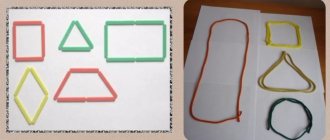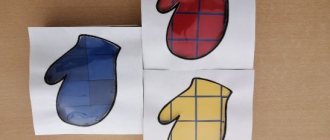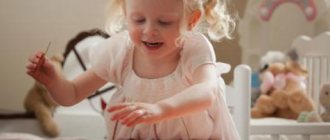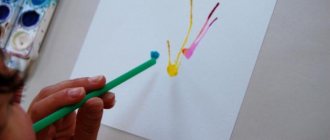From the author
The successful implementation of program objectives depends on a number of factors and, above all, on the way of life of a preschool institution, the atmosphere in which the child is raised, and on a specially designed, thoughtful developmental environment.
The effectiveness of education and training is achieved through the painstaking work of teachers who work directly with children and all preschool employees who communicate with preschoolers during the day.
The system of work on teaching children their native language, introducing them to fiction is presented in the works of V. V. Gerbova “Development of speech in kindergarten”, “Introducing children to fiction” (M.: Mozaika-Sintez, 2005).
The manual “Classes on speech development in the second junior group of kindergarten”, written within the framework of the “Program of education and training in kindergarten” edited by M. A. Vasilyeva, V. V. Gerbova, T. S. Komarova, supplements recommendations on the most important direction of pedagogical activity - purposeful and systematic training of preschoolers in the classroom. The practical purpose of the book is to provide educators with approximate guidelines for planning lessons (defining topics and learning goals, ways to implement them).
MAGAZINE Preschooler.RF
Project for the development of speech of children of primary preschool age “One is a word, two is a word”Municipal budgetary preschool educational institution kindergarten "Fairy Tale" r.p. Voznesenskoye Nizhny Novgorod region
Project manager: teacher of the 1st qualification category Kurenkova Svetlana Sergeevna r.p. Voznesenskoye, 2017
Project participants: teacher, children of junior group No. 2, parents.
Implementation period: 1 month
Project type: medium-term.
Project type: developmental, practice-oriented.
Integration of educational areas in various types of activities: speech development, social and communicative development, cognitive development, artistic and aesthetic development, physical development.
Problem: children of primary preschool age need comprehensive speech development, including enrichment and activation of vocabulary, development of the grammatical structure of speech, as well as coherent speech.
Relevance of the problem: speech helps children consciously perceive the world around them, and is a means of communication. Children who did not receive appropriate speech development in early preschool age have great difficulty catching up, and in the future this gap in speech development affects their further development. The speech development of a preschooler in accordance with the Federal State Educational Standard for preschool education includes:
- mastery of speech as a means of communication and culture;
- enrichment of the active vocabulary;
- development of coherent, grammatically correct dialogical and monologue speech;
- development of speech creativity;
- development of sound and intonation culture of speech, phonemic hearing; acquaintance with book culture, children's literature, listening comprehension of texts of various genres of children's literature;
- formation of sound analytical-synthetic activity as a prerequisite for learning to read and write.
The goal of the project: the development of speech in children of primary preschool age at different regime moments.
Project objectives:
- purposefully enrich children's vocabulary;
- develop grammatical structure of speech, coherent speech;
- to develop children’s need to communicate with adults and peers;
- cultivate a desire to listen to works of fiction more often;
- increase the competence of parents in matters of speech development of their children.
Expected result: as a result of the implementation of this project, children’s vocabulary will expand and become more active, their ideas about their immediate surroundings will be enriched, the sound culture of speech, expressiveness, and coherent speech will improve, the level of cognitive activity and communication abilities will increase, and the ability to answer questions correctly will improve.
Interaction with parents:
- Parent survey “As your child says” ;
- Consultations “Speech development of children of primary preschool age” ; “Why is articulation gymnastics needed?” , “A book in a child’s life” ;
- Round table "Development of speech of children of primary preschool age through didactic games" ;
- Education of parents: information booklet “Recommendations of a speech therapist for the development of speech in children of primary preschool age” ;
- Photo exhibition “Reading with Mom” ;
- Competition "Rechetsvetik "
PROJECT IMPLEMENTATION PLAN
Stage I. Preparatory stage.
- Selection and study of methodological literature on the topic;
- Diagnostics of children at the beginning of the project (within the project);
- Questioning parents on the topic;
- Selection and development of information and educational material;
- Development of a long-term work plan;
- Creation of a card index of didactic games for speech development, outdoor games with recitatives, finger gymnastics;
- Creation of a “Speech Development Center” in the group;
- Development of the final event “Let’s help Kolobok return home .
Stage II. Project implementation stage.
Organization of educational activities for children within the framework of the project
Table theater “The Three Little Pigs” , “Teremok” , “Zayushkina’s Hut” .
Goal: To improve children’s ability to correctly control dolls on the table and pronounce small lines from a familiar fairy tale.
Theatrical games “How I love mommy” , “Who said “meow”” , “Turnip” , “Who do you want to see on TV” .
Goal: To develop children’s connected speech, the ability to play out familiar works and situations.
Story-role-playing game “Hospital” , “Shop” , daily story mini-games “Drivers” , “Builders” , “Family” , etc.
Goal: Enrich and activate children's words, develop dialogical speech.
Reading fiction
Folklore: “Clean Water” , “Grandfather Hedgehog” , “Tili - Bom” , “Knocking, strumming on the street” , “Brave Men” .
Fairy tales: “Zayushkina’s Hut” , “The Fox is a Lapotnitsa” , “Teremok” , “The Three Little Pigs” .
Poems: K. Chukovsky “The Stolen Sun” , “Joy” , “Doctor Aibolit” , V. Berestov “Spring Tale” , B. Zakhoder “Builders” , S. Mikhalkov “About Mimosa” .
Stories: E. Charushin “Wolf” , L. Tolstoy “Tanya Knew Letters” , “The Bird Made a Nest” , K. Ushinsky “Fox Patrikeevna” .
Goal: To introduce children to new works and repeat their favorite old ones; enrich children's vocabulary, develop dialogical speech, encouraging them to answer the teacher's questions with sentences.
Observations while walking:
- for living or inanimate nature,
- nearby buildings,
- children's activities,
- people's labor.
Goal: To enrich and activate the vocabulary, to develop the ability to answer the teacher’s questions in a sentence, coordinating the words in gender, number, and case.
Working with parents
- Questionnaire “As your child says” ;
- Consulting parents on the topics: “Speech development of children of primary preschool age” ; “Why is articulation gymnastics needed?” , “A book in a child’s life” ;
- Participation of parents in the round table “Development of speech of children of primary preschool age through didactic games” ;
- Information booklet “Recommendations of a speech therapist for the development of speech in children of primary preschool age” ;
- Participation of parents in the photo exhibition “Reading with Mom” .
- Participation of parents in the competition “Speech Flower” (replenishment of the “Center for Speech Development” in the group with didactic games)
Stage III. The final stage.
- Summing up the results of the project “One is a word, two is a word” ;
- Conducting the final event - an open organized educational activity on the development of speech of children in the younger group “Let's help Kolobok return home” ;
- Children's production of the Russian folk tale "Teremok" ;
- Photo exhibition “Reading with Mom” ;
- Summing up the results of the “Rechetsvetik” . Winner's reward ceremony;
- Drawing up recommendations for the development of speech in children of primary preschool age;
- Photo report of the project “One is a word, two is a word .
Bibliography
- Gerbova V.V. Classes on speech development in the second junior group of kindergarten, MOSAIC-SYNTHESIS, 2012.
- Zatulina, G.Ya. Speech development in preschoolers. Second junior group. (from 3 to 4 years) / G.Ya. Zatulina. - M.: TsPO, 2013.
- Karpukhina N.A. Lesson notes for the second junior group of kindergarten. A manual for educators and teachers of preschool educational institutions. — Voronezh, 2010;
- Kolesnikova, E.V. Development of sound culture of speech in children 3-4 years old: Educational and methodological manual for the workbook “One is a word, two is a word” / E.V. Kolesnikova. - M.: Yuventa, 2012.
- Smirnova L.N., Ovchinnikov S.N., Speech development in children 3-4 years old. A manual for educators and parents. – M.: MOSAIC-SYNTHESIS, 2009
- Ushakova O.S., Strunina E.M. Methods of speech development for preschool children. - M., Vlados, 2004;
- Ushakova O.S., Kolunova L.G. Development of figurative speech in preschool children/Kindergarten from A to Z – 2005 – No. 2;
- Ushakova, O.S. Speech development in children 3-5 years old. Program, lesson notes, methodological recommendations (according to the Federal State Educational Standard), additional information. / O.S. Ushakova. — M.: Sphere shopping center, 2015.
| Next > |
Features of speech development in children of the fourth year of life
In the fourth year of life, special attention is paid to developing the need to speak out independently.
Kids speak to communicate, explain, ask for something, and also accompany play actions with speech. One third of their messages and explanations consist of complex sentences, which allows them to improve the syntactic side of children’s speech.
By the age of three, the ability to analyze speech appears. A child, although he himself does not know how to pronounce words correctly, catches when someone else pronounces them incorrectly. Children can distinguish similar sounding words (Sashulka - icicle). However, it is too early to talk about speech perfection of hearing (coherent speech is more difficult to perceive by ear than individual words).
At this age, children begin to hear and reproduce some intonations (joyful, edifying, interrogative).
Although the fourth year is a period of intensive assimilation of sounds, along with their correct pronunciation, omission, replacement, assimilation and softening of sounds are observed in children’s speech (the pronunciation of soft sounds is easier for the child than hard ones).
The correct pronunciation of sounds in a child is easily disrupted due to fatigue, illness, or communication with small children who speak poorly.
Pronunciation defects make it difficult to master the grammatical structure of speech and prevent the child from communicating with peers, since his statements are difficult to understand by others.
In children 3–4 years old, breathing is intermittent, and the rate of speech is accelerated (less often, slow), so it can be difficult to listen to them. In this regard, the content of work on developing the sound culture of speech includes exercises to improve breathing, strength, and pitch of the voice.
The problem of forming a dictionary also has many aspects. It is known that in the third year of life, children easily recognize individual objects (vegetables, furniture, dishes, etc.), but do not always name them correctly. By the age of three, children perceive objects, trying to characterize their signs, qualities, and actions with them.
Understanding some of an adult's questions regarding familiar objects can cause difficulties for children, in particular when the object acts as an object of action. Children, looking at the picture, accurately answer the question “Who (what) is this?” (girl, doll, pants, needle, thread), but to the question “Who does the girl sew pants for?” some of them answer “The bear is sewing” (just recently the teacher was sewing up the little bear’s pants).
In the dictionary of children of the fourth year of life, significant quantitative fluctuations are recorded, which are explained by the individual characteristics of the development of children.
Unfortunately, researchers still rely on E. Arkin’s data on the composition of vocabulary in children of the fourth year of life, published in 1968. (It is possible that a modern child has different quantitative characteristics.) So, according to E. Arkin, in a child’s dictionary: nouns and pronouns make up 50.2%, verbs – 27.7%, adverbs – 5%, adjectives – 11.8% [ 1] .
Children quite successfully master the so-called everyday vocabulary, which helps them communicate. In addition, it is necessary to help children learn words denoting parts and details of objects, their qualities. Some generic concepts should be introduced into the dictionary, otherwise children group objects based on random rather than essential features.
At this age, children intensively master prepositions, conjunctions, and question words (the basis for improving syntax).
Vocabulary work is closely related to work on improving the grammatical structure of speech (word formation, inflection, etc.).
Children distinguish words based on the prefix, suffix (came - left - came, cup - cup). Kids master the agreement of singular past tense verbs with nouns, the correct forms of the genitive and accusative plural cases of nouns (boots, mittens, foxes), possessive adjectives (hare, fox); begin to use adjectives and adverbs in the comparative degree.
It is known that the development of the grammatical structure of speech occurs especially quickly in the second half of the third year of life. (According to researchers, up to three and a half years, and according to some indicators, up to four years, speech does not change significantly.)
In the fourth year of life, the number of simple common sentences gradually increases, and complex sentences appear.
At this age, children ask questions that are not related to their direct experience. (“This is a rabbit. What’s his last name?” “At night the sun turns into the moon?” “What kind of relative are you?” (Addresses the teacher.))
In the second half of the year, the number of questions aimed at clarifying cause-and-effect relationships increases.



